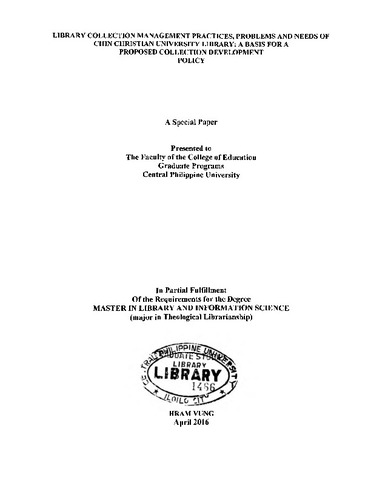| dc.description.abstract | This study determined the access, extent of utilization, and perception on efficiency use of library resources, services and facilities of the University of St. La Salle Graduate Program by graduate program students enrolled in five different programs for the Academic Years 2009 - 2013.
A descriptive-relational type of research was used. It conducted a one-shot survey design to gather data. A self-directed questionnaire prepared by the researcher served as research instrument. The researcher employed stratified sampling to identify the study sample. The respondents from the population were from the five different programs offered by the Graduate School.
Majority of the students’ profile fell between 31-50 years old, were female, and were from the Business Program.
Most of the students found newspapers, books and theses/dissertations to be “easily accessible,” journals, Filipiniana, dissertation abstract international to be “accessible,” and Proquest and elibrary USA to be “not accessible.” For library services, the library schedule, automated circulation, online search, Online Public Access Catalog (OPAC), and online renewal/reservation were found to be “easily accessible” by majority xiii were the study carrels, overall library amenities, and the Online Public Access Catalog (OPAC) terminals. Majority of the students found the Card Catalog and Computer Units to be “accessible.”
Most of the respondents’ “often” utilized all library resources. Most students were found to “always” utilize the library schedule, and online search, online renewal/reservation; while the ones that were “often” utilized by most were the Online Public Access Catalog (OPAC), automated circulation, personalized assistance/reference interview, book display, Path Finder, library orientation, inter library referral/letter to other school, WiFi access, and the Internet. Majority of the students also “always” utilized overall library amenities and the OP AC terminal, while those “often” utilized were study carrels, computer units and card catalog. Newspapers, books, theses/dissertations, journals, and Filipiniana were very efficient while the eLibrary, Dissertation Abstract International (DAI), and ProQuest were efficient. Among the services, online renewal/reservation, book display, automated circulation, library schedule, online search, library orientation, OPAC, PathFinder, and personalized assistance were very efficient whereas inter library referral, WiFi, and Internet were efficient.
There is no significant relationship between students’ age, sex, and degree program and access to library resources, services, and facilities. There is no significant relationship between age, sex and access to library resources, services, and facilities. While there is no significant relationship between degree program and access to library services and facilities, there is a significant relationship between degree program and access to library resources.
There is no significant relationship between respondents’ age, sex, and utilization of library resources, services, and facilities. There is no significant relationship between degree program and utilization of library facilities. There is, however, a significant relationship between degree program and utilization of library resources and services.
The results show that access to library resources and facilities affected the students’ perception of their efficiency. Access to library services is not significantly related to the perception of its efficiency.
There is a significant relationship between the utilization of library resources and services and the perception on the efficiency of library resources and services. The utilization of library facilities has no effect in the perception of efficiency of the facilities.
The study revealed that most of the library resources, services, and facilities are deemed very efficient. There are some though that require attention such as the online database, Internet and WiFi. | en_US |





